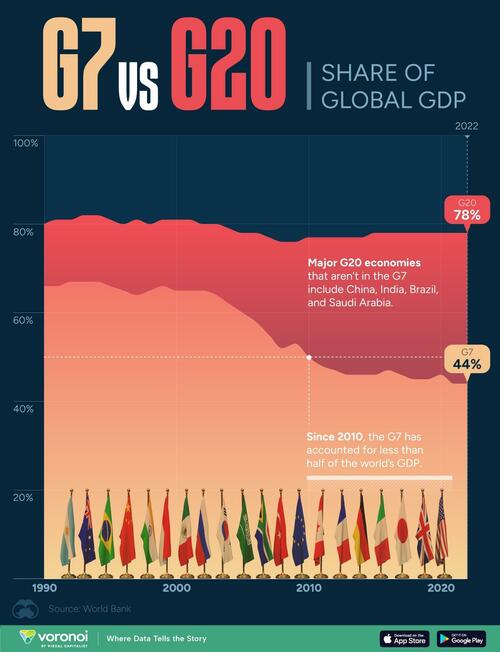Visualizing The G7’s Declining Share Of Global GDP
Formed in 1975, the G7 is a group of seven advanced economies (U.S., Canada, UK, Germany, France, Italy, Japan) that cooperates on economic policy and promotes global stability. At the time of the group’s inception, these countries were leading nations in the post-World War II economic order, and shared similar political and economic systems.
While much of this is still true today, the G7’s collective economic influence has fallen significantly as emerging nations in other parts of the world have grown.
To learn more about this trend, Visual Capitalist’s Marcus Lu visualized the G7’s share of global GDP beside the G20’s, from 1990 to 2022. Numbers come from the World Bank, accessed via the Council on Foreign Relations.
Data and Key Takeaway
The G20 is an expanded group that was established with the goal of bringing together advanced and emerging economies to promote international cooperation. Major economies that are in the G20, but not in the G7, include China, India, Brazil, and Saudi Arabia.
The data we used to create this graphic can be found in the table below.
Year
G7 share of GDP (%)
G20 share of GDP (%)
1990
66
80
1991
66
81
1992
67
81
1993
67
82
1994
67
82
1995
66
81
1996
65
80
1997
64
81
1998
65
80
1999
66
81
2000
65
81
2001
65
81
2002
65
80
2003
64
80
2004
62
79
2005
60
78
2006
58
78
2007
55
77
2008
52
76
2009
53
76
2010
50
77
2011
48
77
2012
47
77
2013
46
77
2014
46
77
2015
46
78
2016
47
78
2017
46
78
2018
45
78
2019
45
78
2020
46
78
2021
44
78
2022
44
78
From this dataset we can see that the G7’s share of global GDP has shrunk from 67% in 1994, to 44% in 2022.
Over this same time period, the G20’s share of global GDP has remained relatively steady near 80%. In short, this means that emerging markets are accounting for a relatively greater share of the world’s economy.
What Does This Mean for the G7?
Here are some possible consequences of the G7’s declining share of global GDP:
Reduced Global Influence: Diminished ability to shape global economic policies and standards.
Changes in Trade Dynamics: Potential shifts in trade relationships and alliances as other countries gain economic prominence.
Altered Investment Flows: Redirection of global investment towards faster-growing economies outside the G7.
If you enjoyed this post, check out this infographic that visualizes the top six countries share of global GDP over time.
Tyler Durden
Tue, 07/16/2024 – 18:00

